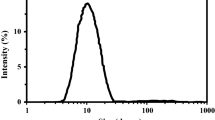Abstract
The mechanism of action of additives for diesel fuel is studied in terms of molecular interactions. Using UV spectrophotometry, electron microscopy, conductivity, and other methods, we give experimental evidence of these interactions in diesel, including in the presence of additives. It is shown for the first time that the efficiency of diesel additives depends on the formation of new structures, such as charge-transfer complexes. Based on the analysis of the chemical structure of various additives, we make a conclusion that they all are classified as surfactants. It is known that diesel fuels are disperse fuel systems. Therefore, the experimental data on decreasing surface tension at the interface of a disperse fuel system in the presence of additives indicate that the additives are fuel stabilizers. A conclusion is drawn that additives that differ in chemical structure and have different functional purposes, including multifunctional additives, operate in a fuel disperse system by a common mechanism that is similar to the action of surfactants in classical disperse systems. This mechanism is associated with an increase in the stability of a disperse fuel system in the presence of additives and, as a consequence, with an improvement in its quality.
Similar content being viewed by others
References
R. A. Terteryan, Depressor Additives for Crude Oils, Fuels and Lube Oils (Khimiya, Moscow, 1990) [in Russian].
S. T. Bashkatova, Diesel Additives (Khimiya, Moscow, 1994) [in Russian].
A. M. Danilov, Introduction to Fuel Chemistry (Tekhnika, OOO “TUMA GRUPP”, Moscow, 2003) [in Russian].
I. N. Grishina, Physicochemical Principles of Synthesis, Production, and Application of Improving Diesel Fuel Additives (Neft’ i Gaz, Moscow, 2007) [in Russian].
Z. I. Syunyaev, R. Z. Syunyaev, and R. Z. Safieva, Disperse Petroleum Systems (Khimiya, Moscow, 1990) [in Russian].
Yu. G. Frolov, Treatise of Colloid Chemistry: Surface Phenomena and Disperse Systems (Al’yans, Moscow, 2004) [in Russian].
T. P. Zhuze, Extended Abstract of Doctoral Dissertation in Chemistry (Moscow, 1949).
T. P. Zhuze, Kolloidn. Zh. 13, 27 (1951).
L. G. Gurvich, Neft. Slants. Khoz., No. 8, 350 (1924).
N. I. Chernozhukov, Neft. Slants. Khoz., No. 5, 355 (1924).
P. I. Sanin, N. V. Melent’eva, and Yu. M. Zelenova, Kolloidn. Zh. 18, 745 (1956).
J. Denis and J-P. Durand, Rev. Inst. Francais Pet. 46, 637 (1991).
G. Odian, Principles of Radical Polymerization (McGraw-Hill, New York, 19970; Mir, Moscow, 1974).
Kh. S. Bagdasar’yan, Theory of Radical Polymerization (Nauka, Moscow, 1966) [in Russian].
S. E. Bresler and B. L. Erusalimskii, Physics and Chemistry of Macromolecules (Nauka, Leningrad, 1965) [in Russian].
D. Shevtsov, Avtorevyu, No. 21, 1 (2002).
A. A. Tager, in Physical Chemistry of Polymers (Khimiya, Moscow, 1968) [in Russian].
V. A. Kargin and G. L. Slonimskii, Short Essays on Physical Chemistry of Polymers (Khimiya, Moscow, 1967) [in Russian].
S. T. Bashkatova, A. S. Kazanskaya, and V. A. Vinokurov, Theoretical Principles of Application of Polymer Solutions in Oil and Gas Industry: A Textbook (Neft i Gaz, Moscow, 2005) [in Russian].
E. N. Kabanova, Extended Abstract of Candidate’s Dissertation in Technical Science (Moscow, 2006).
G. V. Tolstova, G. I. Shor, B. A. Englin, et al., Khim. Tekhnol. Topl. Masel, No. 2, 38 (1980).
L. I. Mekenitskaya, S. T. Bashkatova, and O. B. Semenov, (1988).
S. T. Bashkatova and V. A. Vinokurov, RU Patent No. 2119528 (1997).
G. N. Lanchakov, E. N. Kabanova, S. T. Bashkatova, et al., RU Patent No. 2280067 (2005).
G. N. Lanchakov, E. N. Kabanova, S. T. Bashkatova, et al., RU Patent No. 2280068 (2005).
G. N. Lanchakov, E. N. Kabanova, S. T. Bashkatova, et al., RU Patent No. 2280069 (2005).
R. S. Suleimanov, O. P. Kabanov, O. E. Obukhov, et al., RU Patent No. 2320705 (2006).
R. S. Suleimanov, V. A. Stavitskii, O. P. Kabanov, et al., RU Patent No. 2320706 (2006).
R. S. Suleimanov, S. V. Sorokin, O. P. Kabanov, et al., RU Patent No. 2320707 (2006).
Author information
Authors and Affiliations
Corresponding author
Additional information
Original Russian Text © S.T. Bashkatova, V.A. Vinokurov, I.N. Grishina, Yu.B. Egorkina, 2011, published in Neftekhimiya, 2011, Vol. 51, No. 5, pp. 369–375.
Rights and permissions
About this article
Cite this article
Bashkatova, S.T., Vinokurov, V.A., Grishina, I.N. et al. Intermolecular interactions in a disperse fuel system and their contribution to the mechanism of action of diesel fuel additives. Pet. Chem. 51, 363–369 (2011). https://doi.org/10.1134/S0965544111030030
Received:
Published:
Issue Date:
DOI: https://doi.org/10.1134/S0965544111030030




